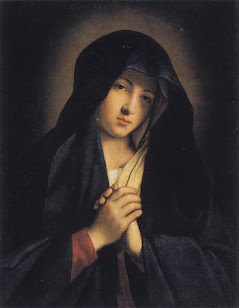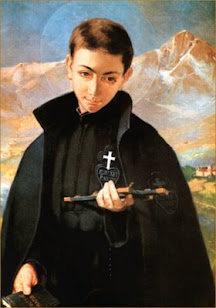On February 22, we remember and celebrate Saint Margaret of Cortona (1247-1297), a model of Christian redemption and conversion. Saint Margaret is sometimes referred to as the Second Mary Magdalene, recognized for her turn from sin to exemplary holiness.
Born in Tuscany, Margaret’s parents owned and opearated a small farm. Her early years were filled with love, but Margaret by all accounts was willful and unsatisfied. She quickly outgrew the small town of Laviano, and looked to embrace the larger world. Being a beautiful and endearing child, she soon learned to use these attributes to her advantage, first with local men, and later with those of higher class and privilege. When Margaret was just seven years old, her mother passed away, but not before she taught here a simple prayer: "O Lord Jesus, I beseech thee, grant salvation to all those for whom thou wouldst have me pray." It seemed that her mother was the steadying influence in Margaret’s life, and following her death, the young woman became more indulgent and lived to excess. After her father remarried, Margaret’s stepmother was appalled by her behavior, and strove to punish her. The atmosphere of restriction and rules led Margaret to run away at age 17, eventually landing in the arms of a Multepulciano nobleman.
Given her lineage, the nobleman Arsenio could not marry Margaret. Instead he moved her into his castle as his mistress, where she lived for nearly ten years. Their relationship produced a son, who Margaret prized above all else. While many who recount her Holy legend assert that she lived a wanton, sinful life with Arsenio, in her confessions, Margaret reports that she was an unwilling participant in the physical aspects of their relationship. Arsenio promised to marry her, repeatedly, a promise which he never fulfilled.
When Margaret was 27, everything changed. Arsenio had gone out hunting, and failed to return. Instead, his favorite hound, who had accompanied him, returned alone and found Margaret in her room. The hound led Margaret deep into the forest, where she discovered the murdered body of Arsenio. Margaret was deeply moved, blaming herself and her beauty for his unfortunate death, and immediately turned to a life of penance for her wrongdoings. She first returned all the jewels and gifts bestowed on her by Arsenio to his family, leaving the castle. She returned home to her father in repentence, but was turned away due to her son and sinfulness. In desparation, Margaret turned to the Franciscan Friars at Cortona, who took her in following a tearful and sincere confession.
The Friars assigned Margaret to live with two elderly women who spent much of their time in service to those less fortunate. There, Margaret struggled for three years, fighting against all wordly tempations, including those of the flesh. She prayed endlessly for forgiveness, and engaged in acts of mortification, including total abstinence from meat. Given that she had previously lived a life of luxury, she opted to embrace the opposite in penance. Where she had eaten her fill, she now ate little. Where she had slep on the finest beds, she now chose to sleep on the hard ground. Having formerly worn the finest clothing, she now literally dressed herself in rags. Repentant for her beauty, she attempted to disfigure herself by bruising and cutting her face, but the Friars forbade her to continue these forms of intemperate mortification.
After three years, Margaret was admitted to the Third Order of Saint Francis. She devoted herself entirely to serving the poor, herself subsisting on alms and begging. In 1277, as she knelt in prayer at the Franciscan church, she heard the words, "What is thy wish, poverella?" Without hesitation, Margaret replied, "I neither seek nor wish for anything but Thee, my Lord Jesus.” From that point on, Margaret experienced frequent divine communication with Christ, as evidenced by her frequent ecstasy. "I have put thee as a burning light," Our Lord said to her, "to enlighten those who sit in the darkness.--I have set thee as an example to sinners, that in thee they may behold how my mercy awaits the sinner who is willing to repent; for as I have been merciful to thee, so will I be merciful to them."
Margaret faithfully bore messages to others that she received in her visions, braving ridicule and at times bodily harm. Based upon His instructions, Margaret petitioned the city of Cortona to found a hospital for the sick, homeless and impoverished, where she tirelessly served. She instituted a congregation of Franciscan Tertiary Sisters, known as "le poverelle" after the name Jesus initially used to address her (later He would come to refer to her as “My child.”). Margaret also established a confraternity to Our Lady of Mercy and the members bound themselves to support the hospital and to help those in need.
Shortly before her death, Saint Margaret had a vision of Saint Mary Magdalene, "most faithful of Christ's apostles, clothed in a robe as it were of silver, and crowned with a crown of precious gems, and surrounded by the holy angels." While was in this ecstasy, Christ spoke to Margaret, saying, "My Eternal Father said of Me to the Baptist: This is My beloved Son; so do I say to thee of Magdalene: This is my beloved daughter." On another occasion Margaret’s confessor recorded that in ecstasy "she was taken in spirit to the feet of Christ, which she washed with her tears as did Magdalene of old; and as she wiped His feet she desired greatly to behold His face, and prayed to the Lord to grant her this favor."
Divinely warned of the day and hour of her death, Saint Margaret died on February 22, 1297, at the age of fifty, having spent twenty-nine years performing acts of penance. Her incorrupt body was laid to rest on a silver alter at the Church of Saint Basil, where it remains today.
The life of Saint Margaret of Cortona is a beautiful story of sin, repentance, and forgiveness. Margaret struggled with temptation throughout her life, remaining human until her death. “My father," she said to her confessor one day, "do not ask me to give in to this body of mine. I cannot afford it. Between me and my body there must needs be a struggle until death." Despite her struggle, Margaret found a deep devotion to the mysteries of the Eucharist and the Passion of Christ. In her devotion, she communicated directly with the Lord, who set her apart as an example for sinners through her faith. It seems entirely appropriate for us to meditation on the life of Saint Margaret during Lent, as we take inventory of our sinful ways, and turn to the Lord with confidence in his love and forgiveness.
O holy Margaret of Cortona, I am here before this image of Jesus crucified which has spoken to you so many times. Obtain for me, too, the grace of hearing His voice: Through His Word, through prayer, and the events of life.
O Jesus Crucified, increase my faith and grant me, as you granted to holy Margaret, the grace of a sincere repentance from my sins; make me at one with the most needyand accompany me, I ask you, to the Father's house. Amen
Day 53 of 365
Prayer Intentions: Prayerful contrition for sins; Willingness to humbly repent before the Lord.
Requested Intentions: For the health of a family member with Rett’s Disorder (C); For the restoration of hearing (L); For a restorative, faith-deepening Lent for all those who are struggling (L); For a niece suffering with autism, and for all those affected by autism (V); For a daughter’s employment (J); For a son’s employment and growth in faith (M).
Special Intentions (Day 12 of 45-day Novena to Our Blessed Lady of Lourdes): The intentions of all those who read this blog, whether submitted or retained in the quiet of their hearts; Penance, Penance, Penance for sinners; For all those who are suffering.
Why pray the Rosary every day for a year?
Each time the Blessed Virgin has appeared-- whether it be to Saint Bernadette Soubirous at Lourdes; to Lucia, Jacinta, and Francisco at Fatima; or to Mariette Beco at Banneux-- she has asserted the importance, saving grace, and power of praying the Holy Rosary on a daily basis. Based upon her words, the Rosary is penance and conversion for sinners, a pathway to peace, an end to war, and a powerful act of faith in Jesus Christ. Pope Paul VI presented the Rosary as a powerful means to reach Christ "not merely with Mary but indeed, insofar as this is possible to us, in the same way as Mary, who is certainly the one who thought about Him more than anyone else has ever done."
To show us how this is done, perhaps no one has been more eloquent than the great Cardinal Newman, who wrote: "The great power of the Rosary consists in the fact that it translates the Creed into Prayer. Of course, the Creed is already in a certain sense a prayer and a great act of homage towards God, but the Rosary brings us to meditate again on the great truth of His life and death, and brings this truth close to our hearts. Even Christians, although they know God, usually fear rather than love Him. The strength of the Rosary lies in the particular manner in which it considers these mysteries, since all our thinking about Christ is intertwined with the thought of His Mother, in the relations between Mother and Son; the Holy Family is presented to us, the home in which God lived His infinite love."
As Mary said at Fatima, "Jesus wants to use you to make Me known and loved. He wishes to establish the devotion to My Immaculate Heart throughout the world. I promise salvation to whoever embraces it; these souls will be dear to God, like flowers put by Me to adorn his throne."
Subscribe to:
Post Comments (Atom)




Thank God For Saint Margaret